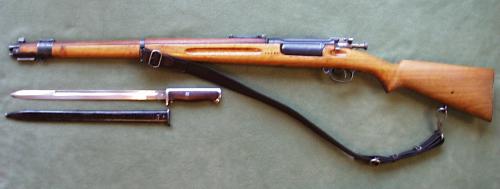
 |
|
|
|
|
#1 | |
|
Member
Join Date: Dec 2004
Location: Singapore
Posts: 1,180
|
Quote:
Just a question -- is this a Lombok pedang because of the slender profile of the blade? Sumatra has a lot of klewangs with hilts like this (abstract makara), and blades of similar, although broader, forms. |
|
|
|

|
|
|
#2 |
|
Member
Join Date: Dec 2005
Posts: 164
|
It is odd how the spine of the blade runs down and then the end (that is usually kicked up on most knifes ) is kicked down away from the spine.
I thought I was holding it upside down at first and I have to be careful when I sheath it and make sure it is right side up. Is this a common trait of this type of blade? |
|
|

|
|
|
#3 |
|
Member
Join Date: Jun 2005
Posts: 210
|
This is a shot in the dark; but, the blade on this one looks as though it may have once been part of a Norwegian bayonet. The blade on the model 1894 would have been around 367mm long, 19.5mm wide, and 5mm thick. It is hard to see due to the extensive acid damage, but there seems to be a machine made fuller running along the top of the blade which starts an inch in front of the guard and ends just before the hook (clip point). Originally the blade had a spear point with a sharpened spine. This one seems to have lost a short section of point, which was corrected by rounding the clip point all the way down to the main edge.
 original model 1894 bayonet and rifle see: Kiesling vol 1#247, Janzen's pg 151-3 for sketches of the original bayonet. n2s |
|
|

|
|
|
#4 |
|
Member
Join Date: Dec 2004
Location: The Netherlands
Posts: 1,209
|
This is a sumatran pedang. A very nice one with that inscription. I don't think that it was original a bayonet.
|
|
|

|
|
|
#5 | |
|
Member
Join Date: Dec 2004
Location: Singapore
Posts: 1,180
|
Quote:
Here's my Acehnese pedang with the same tip. The only difference is that it is probably more than twice as broad. http://www.kampungnet.com.sg/modules...view_photo.php Here are some more examples, with different sheath and handle forms. http://www.geocities.com/keris4u/oth...ricik_luwu.htm http://www.geocities.com/keris4u/oth...a_dwiwarna.htm http://www.geocities.com/keris4u/oth...ricik_luwu.htm |
|
|
|

|
|
|
#6 |
|
Member
Join Date: Dec 2005
Posts: 164
|
Thanks for the answers.
I also do not believe it was ever a bayonet(Nice rifle Not2Sharp) If you look close at the details of the blade it seems to be layered metal.It is hard to see because of the "acid damage" and in the pics but up close in person I can see layering. If I dipped a regular blade or bayonette into acid would it reveal layering? Thanks again |
|
|

|
|
|
#7 | |
|
Vikingsword Staff
Join Date: Nov 2004
Posts: 6,378
|
Quote:
How long is this blade ? |
|
|
|

|
|
|
#8 |
|
Member
Join Date: Dec 2005
Posts: 164
|
The blade is 20.5 inches long and 3/4 of an inch wide at the Hilt and 1 and 1/8 inches wide at the end before the point turns down.The spine is 1/4 of an inch wide at the hilt and 1/8 at the end where the blade turns down to a point.
Thanks |
|
|

|
|
|
#9 |
|
Member
Join Date: Jul 2005
Location: Toronto, Canada
Posts: 1,242
|
Hello Bluerf and all,
I thought this sword was very similar to the one presented here http://old.blades.free.fr/swords/pedang_sab/ped04.htm and originating from Lombok. While the hilts seem to be very commonly used in Sumatra, these two examples also have very similar tips. In both cases it is finer/sharper than other examples and it is so down-curving that it almost forms a sort of hook. I have barely started studying Indonesian weapons, but these similarities caught my eye. Another question about the hilts would be who uses specific makara (with trunk) depictions and who uses other combinations of flora/fauna in similar manner? Could the specific details be used for identification or are they far too generic? Regards, Manolo |
|
|

|
 |
|
|